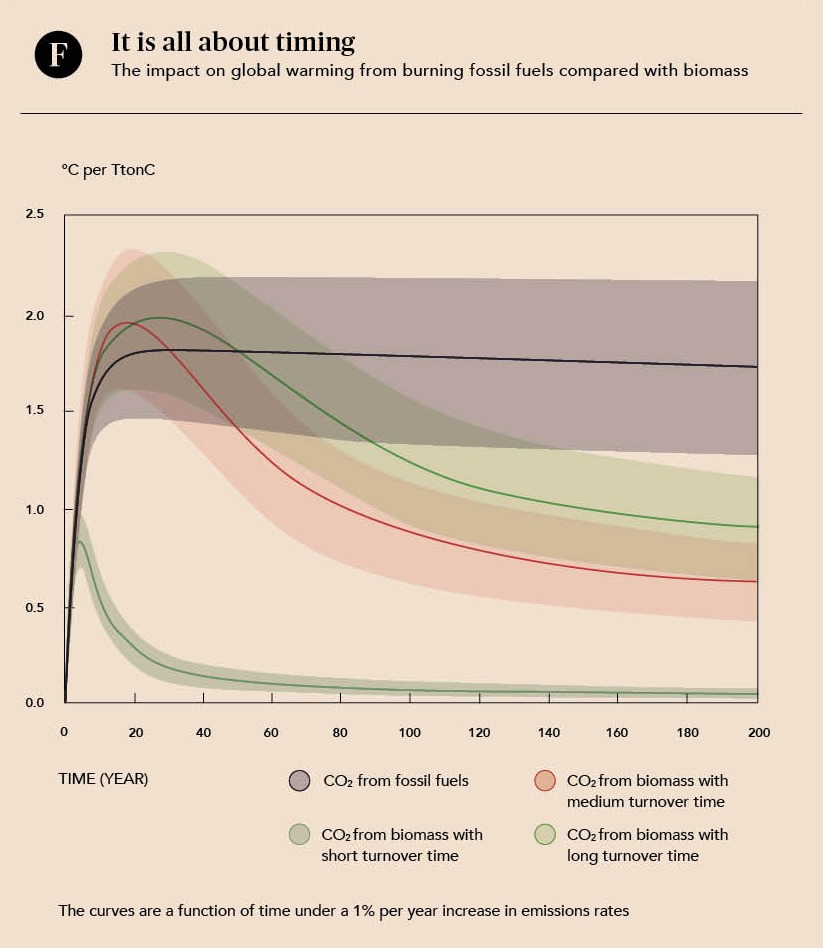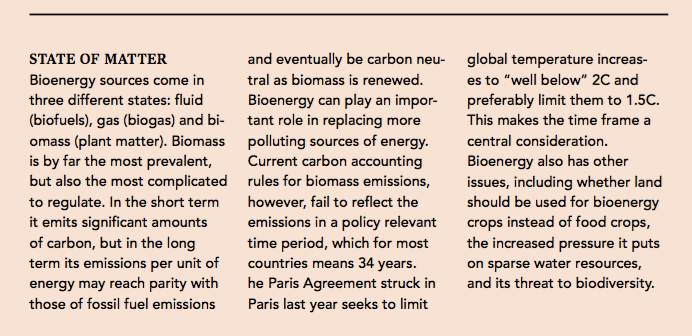A BURNING QUESTION
Most international bodies, including the Intergovernmental Panel on Climate Change (IPCC), treat biomass combustion as a carbon neutral process. Biomass is the most significant renewable energy source, currently making up around 10% of global primary energy distribution compared with just 1% from wind and solar combined, according to the IPCC. Countries are turning to biomass as a means to decarbonise their economies partly because they believe it to be carbon neutral. Bioenergy power generation globally has taken of, with electricity from biomass more than doubling in the past decade. In light of this growth, a relevant question being asked is whether biomass, a renewable energy source, is really carbon neutral. The prevailing opinion has been that as biomass grow, carbon is temporarily removed from the atmosphere and when the biomass decay or is burned, the carbon is released back into the atmosphere. In other words, it is simply a part of the natural carbon cycle.
The problem with that reasoning, say its doubters, is that carbon neutrality is not linked to CO2 absorption in the past, but to what happens in future. For biomass combustion to be carbon neutral, all the CO2 released by burning plant matter today would have to be reabsorbed tomorrow by an equivalent amount of new biomass.
A memo item
Replacing short-lived plants and crops is fairly easy but replacing wood is another issue. It can take decades for the reabsorption of carbon by forests and given that trees grow back slowly, that leaves a carbon debt to be compensated for. Currently, carbon emissions from biomass combustion are registered as no more than a as a memo item in energy sector pollution accounting; they are not added to total energy sector emissions, because they are already accounted for in the land and forestry sector, when biomass is removed. This methodology avoids the risk of double-counting, but could be masking a bigger problem. A growing body of research argues that it is wrong to presume that biomass combustion is carbon neutral, says Helmut Haberl, an IPCC lead author on land-use change. “I do not think it will be possible to keep the general assumption of carbon neutrality of biomass alive for long anymore,” he says. Future studies, he adds, will continue to support that view and show carbon neutrality to be a rarity.
Moreover, what if the harvested plants had not been used for bioenergy? “In many cases, the land would have sequestered carbon. This carbon sequestration is lost if the land is used for bioenergy,” says Haberl. He stresses that the direct and indirect land-use effects of bioenergy can result in bioenergy being more carbon intensive than fossil fuels.
Voluntary heart-searching
Replacing coal with wood has become a popular choice for energy companies under environmental pressure. Depending on the type of wood burned, however, it can take from ve to 50 years before the burned biomass is replaced, or even longer. The scientific community has for years cautioned against treating biomass this way. In 2011, the European Environment Agency’s scientific committee concluded “this mistaken assumption results in a serious accounting error”. The scientific panel advising the US Environmental Protection Agency echoed this by stating “carbon neutrality cannot be assumed for all biomass energy a priori” in a 2012 report. This criticism has only gained in size ever since and several researchers are calling for new regulation.
Pellets and chips
To keep up with the latest knowledge and pre-empt future regulation, the Danish District Heating Association and the Danish Energy Association have introduced an industry-initiated voluntary framework for sustainable criteria of solid biomass (wood pellets and wood chips). Beginning in late summer 2016, all Danish combined heat and power plant exceeding 20 MW will start documenting biomass sustainability. Central to the efforts is ensuring that biomass is not illegally logged and is done in a way that reduces the environmental impacts. The European Commission is expected to propose new criteria for biomass sustainability this year or next. A key issue for the industry is whether the proposal will come through a revision of the Renewables Directive, build on top of the existing criteria for biofuels, or emerge as a separate new policy specifically for biomass. The route taken will determine how fast new regulations are applied. •


TEXT Peter Bjerregaard